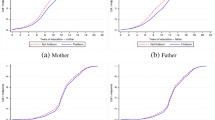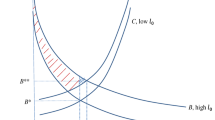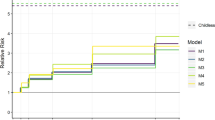Abstract
Contemporary stratification research on developed societies usually views the intergenerational transmission of educational advantage as a one-way effect from parent to child. However, parents’ investment in their offspring’s schooling may yield significant returns for parents themselves in later life. For instance, well-educated offspring have greater knowledge of health and technology to share with their parents and more financial means to provide for them than do their less-educated counterparts. We use data from the 1992–2006 Health and Retirement Study (HRS) to examine whether adult offspring’s educational attainments are associated with parents’ survival in the United States. We show that adult offspring’s educational attainments have independent effects on their parents’ mortality, even after controlling for parents’ own socioeconomic resources. This relationship is more pronounced for deaths that are linked to behavioral factors: most notably, chronic lower respiratory disease and lung cancer. Furthermore, at least part of the association between offspring’s schooling and parents’ survival may be explained by parents’ health behaviors, including smoking and physical activity. These findings suggest that one way to influence the health of the elderly is through their offspring. To harness the full value of schooling for health, then, a family and multigenerational perspective is needed.
Similar content being viewed by others
Notes
Using data from the General Social Survey, Pampel (2005) estimated that among whites, the percentage of ever having smoked peaks for cohorts born 1923–1938. This corresponds well to the main HRS cohort in this analysis: those born 1931–1941. Indeed, a large portion of our sample was born during the early era of smoking. The HRS sample used in this article has a median year of birth of 1934, and more than 45 % of the parents in our sample were born between 1923 and 1938.
We use “HRS” to refer to all Health and Retirement Study (HRS) cohorts.
Although we consider wealth as a covariate in preliminary analyses, wealth is not included in the models depicted in this article. Parents have the choice either to invest their wealth in their offspring’s schooling and receive the benefit of highly educated offspring in later life, or to hold onto their wealth and use this money to help themselves as they see fit. Wealth is therefore endogenous to offspring’s schooling and may confound the results of this study.
This data set (RAND-HRS Data, Version J) is produced by the RAND Center for the Study of Aging, with funding from the National Institute on Aging and the Social Security Administration, Santa Monica, CA (March 2010).
We control for current spouse’s educational attainment in order to adjust for another aspect of the respondent’s current socioeconomic status. The correlation for husband’s and wife’s schooling is .60.
In these analyses, we include only respondents’ and spouses’ biological, adopted, and stepchildren.
Details regarding drops and recoding of the child roster data are available in Online Resource 1.
Another way of thinking about offspring’s education as it affects parents is in terms of three component parts: the average offspring’s education (as described herein), the number of offspring from whom parents receive educational benefit, and the number of years that parents were exposed to adult offspring. Parents who have children early will have more years of educational exposure than parents who have their children later, and there may be important benefits associated with each additional year of exposure. In addition, parents with the same average education of offspring may fare differently depending on how many adult offspring they have. In preliminary analyses, we calculated a variable that we termed “cumulative educational exposure” (CEE), which was measured as CEE = number of adult offspring × mean years of education × total years of exposure to adult offspring. However, we found that average educational attainment of offspring was the main factor guiding the association between offspring’s schooling and parental mortality, and we therefore consider only offspring’s attainments in this article.
Questions asking about vigorous activity were not asked of the 1993 AHEAD respondents. This variable is treated as missing for these respondents in that wave.
Online Resource 2 contains additional details regarding smoking and exercise question wording and availability across waves.
In results not shown here, we also included wealth as an additional family-level socioeconomic control. The results from the model with wealth are very similar to those from Model 5 with income alone.
In analyses not displayed here, we examined whether the relationship between offspring’s schooling and parental mortality varies by parents’ educational attainment and age. We found no interaction effect of offspring’s and parents’ own educational attainments. More- and less-educated parents benefit to similar degrees from having more-educated offspring. In addition, we found that the association between offspring’s schooling and mortality weakens as parents age.
In supplemental analyses, we also incorporated information on health behaviors in our cause-specific hazard models and found that smoking and exercise behaviors explain some of the relationship between offspring’s schooling and parental cause of death, especially lung cancer deaths. (See Table S3.1 in Online Resource 3.) This confirms that these health behaviors play an important role in smoking-related deaths in particular.
We thank an anonymous reviewer for bringing this to our attention.
References
Berkman, L. F., Glass, T., Brissette, I., & Seeman, T. E. (2000). From social integration to health: Durkheim in the new millennium. Social Science & Medicine, 51, 843–857.
Bonsang, E. (2009). Does informal care from children to their elderly parents substitute for formal care in Europe? Journal of Health Economics, 28, 143–154.
Boyle, M. H., Sanford, M., Szatman, P., Merikangas, K., & Offord, D. R. (2001). Familial influences of substance use by adolescents and young adults. Canadian Journal of Public Health, 92, 206–209.
Brown, M., Mazzocco, M., Scholz, J. K., Seshadri, A. (2006). Tied transfers (Online working paper). Madison: Department of Economics, University of Wisconsin–Madison.
Chang, V. W., & Lauderdale, D. S. (2009). Fundamental cause theory, technological innovation, and health disparities: The case of cholesterol in the era of statins. Journal of Health and Social Behavior, 50, 245–260.
Christakis, N. A., & Fowler, J. H. (2007). The spread of obesity in a large social network over 32 years. New England Journal of Medicine, 357, 370–379.
Christakis, N. A., & Fowler, J. H. (2008). The collective dynamics of smoking in a large social network. New England Journal of Medicine, 358, 2249–2258.
Compton, J., & Pollak, R. A. (2009). Proximity and coresidence of adult children and their parents: Description and correlates (Online working paper). Retrieved from http://jenni.uchicago.edu/Spencer_Conference/Representative%20Papers/Pollak_Proximity%20and%20Coresidence.pdf
Couch, K. A., Daly, M. C., & Wolf, D. A. (1999). Time? Money? Both? The allocation of resources to older parents. Demography, 36, 219–232.
Cox, D. R. (1972). Regression models and life-tables. Journal of the Royal Statistical Society: Series B: Methodological, 34, 187–220.
Cox, D. R. (1975). Partial likelihood. Biometrika, 62, 269–276.
DiMaggio, P., Hargittai, E., Neuman, W. R., & Robinson, J. P. (2001). Social implications of the Internet. Annual Review of Sociology, 27, 307–336.
Duncan, C., Jones, K., & Moon, G. (1999). Smoking and deprivation: Are there neighborhood effects? Social Science & Medicine, 48, 497–505.
Eggebeen, D. J., & Hogan, D. P. (1990). Giving between generations in American families. Human Nature, 1, 211–232.
Elo, I. T. (2009). Social class differentials in health and mortality: Patterns and explanations in comparative perspective. Annual Review of Sociology, 35, 553–572.
Elwert, F., & Christakis, N. A. (2008). The effect of widowhood on mortality by the causes of death of both spouses. American Journal of Public Health, 98, 2092–2098.
Escobedo, L. G., & Peddicord, J. P. (1996). Smoking prevalence in US birth cohorts: The influence of gender and education. American Journal of Public Health, 86, 231–236.
Ferrence, R. G. (1989). Deadly fashion: The rise and fall of cigarette smoking in North America. New York, NY: Garland Publishing.
Field, E., & de la Roca, J. (2005). Are there upward intergenerational education spillovers? The influence of children’s schooling on parents’ smoking cessation. Unpublished manuscript, Harvard University, Cambridge, MA.
Fowler, J. H., & Christakis, N. A. (2008). Dynamic spread of happiness in a large social network: Longitudinal analysis over 20 years in the Framingham Heart Study. British Medical Journal, 337, 1–9.
Giles, J., & Mu, R. (2007). Elderly parent health and the migration decisions of adult children: Evidence from rural China. Demography, 44, 265–288.
Glied, S., & Lleras-Muney, A. (2008). Technological innovation and inequality in health. Demography, 45, 741–761.
Hamil-Luker, J., & O’Rand, A. M. (2007). Gender differences in the link between childhood socioeconomic conditions and heart attack risk in adulthood. Demography, 44, 137–158.
Hayward, M. D., & Gorman, B. K. (2004). The long arm of childhood: The influence of early-life social conditions on men’s mortality. Demography, 41, 87–107.
Henretta, J. C., Hill, M. S., Li, W., Soldo, B. J., & Wolf, D. A. (1997). Selection of children to provide care: The effect of earlier parental transfers. Journals of Gerontology. Series B, Psychological Sciences and Social Sciences, 52, 110–119.
Hogan, D. P., Eggebeen, D. J., & Clogg, C. C. (1993). The structure of intergenerational exchanges in American families. American Journal of Sociology, 98, 1428–1458.
Kuh, D., Hardy, R., Langenberg, C., Richards, M., & Wadsworth, M. E. (2002). Mortality in adults aged 26–54 years related to socioeconomic conditions in childhood and adulthood: Post war birth cohort study. British Medical Journal, 325, 1076–1080.
Liang, J., McCarthy, J. F., Jain, A., Krause, N., Bennett, J. M., & Gu, S. (2000). Socioeconomic gradient in old age mortality in Wuhan, China. Journals of Gerontology. Series B, Psychological Sciences and Social Sciences, 55, S222–S233.
Lillard, L. A., & Waite, L. J. (1995). ’Til death do us part: Marital disruption and mortality. American Journal of Sociology, 100, 1131–1156.
Link, B. G. (2008). Epidemiological sociology and the social shaping of population health. Journal of Health and Social Behavior, 49, 367–384.
Luo, Y., Hawkley, L. C., Waite, L. J., & Cacioppo, J. T. (2012). Loneliness, health, and mortality in old age: A national longitudinal study. Social Science & Medicine, 74, 907–914.
Lutfey, K., & Freese, J. (2005). Toward some fundamentals of fundamental causality: Socioeconomic status and health in the routine clinic visit for diabetes. American Journal of Sociology, 110, 1326–1372.
Lye, D. N. (1996). Adult child-parent relationships. Annual Review of Sociology, 22, 79–102.
Lynch, S. M. (2003). Cohort and life-course patterns in the relationship between education and health: A hierarchical approach. Demography, 40, 309–332.
Mare, R. D. (1990). Socioeconomic careers and differential mortality among older men in the United States. In J. Vallin, S. D’Souza, & A. Palloni (Eds.), Comparative studies of mortality and morbidity: Old and new approaches to measurement and analysis (pp. 362–387). London, UK: Oxford University Press.
Mare, R. D., & Palloni, A. (1988). Couple models for socioeconomic effects on the mortality of older persons (Working Paper 88-07). Madison: University of Wisconsin, Center for Demography and Ecology.
McGarry, K. (1998). Caring for the elderly: The role of adult offspring. In D. A. Wise (Ed.), Inquiries in the economics of aging (pp. 133–163). Chicago, IL: University of Chicago Press.
McGarry, K., & Schoeni, R. F. (1995). Transfer behavior in the health and retirement study. Journal of Human Resources, 30(Suppl.), S184–S226.
Mokdad, A. H., Marks, J. S., Stroup, D. F., & Gerberding, J. L. (2004). Actual causes of death in the United States, 2000. Journal of the American Medical Association, 291, 1238–1245.
Pampel, F. C. (2005). Diffusion, cohort change, and social patterns of smoking. Social Science Research, 34, 117–139.
Phelan, J. C., Link, B. G., & Tehranifar, P. (2010). Social conditions as fundamental causes of health inequalities theory, evidence, and policy implications. Journal of Health and Social Behavior, 51(Suppl. 1), S28–S40.
Preston, S. H. (1984). Offspring and the elderly: Divergent paths for America’s dependents. Demography, 21, 435–457.
Preston, S. H., & Wang, H. (2006). Sex mortality differences in the United States: The role of cohort smoking patterns. Demography, 43, 631–646.
Rajan, K. B., Lerouz, B. G., Peterson, A. V., Bricker, J. B., & Anderson, M. R. (2003). Nine-year prospective association between older siblings’ smoking and offspring’s daily smoking. Journal of Adolescent Health, 33, 25–30.
Rende, R., Slomkowski, C., Lloyd-Richardson, E., & Niaura, R. (2005). Sibling effects on substance use in adolescence: Social contagion and genetic relatedness. Journal of Family Psychology, 19, 611–618.
Rogers, R. G., Nam, C. B., & Hummer, R. A. (1995). Demographic and socioeconomic links to cigarette smoking. Social Biology, 42, 1–21.
Schoeni, R. F. (1997). Private interhousehold transfers of money and time: New empirical evidence. Review of Income and Wealth, 43, 423–448.
Seeman, T. E., Berkman, L. F., Kohout, F., LaCroix, A., Glynn, R., & Blazer, D. (1993). Intercommunity variations in the association between social ties and mortality in the elderly: A comparative analysis of three communities. Annals of Epidemiology, 3, 325–335.
Seeman, T. E., Lusignolo, T. M., Albert, M., & Berkman, L. (2001). Social relationships, social support, and patterns of cognitive aging in healthy, high-functioning older adults: MacArthur Studies of Successful Aging. Health Psychology, 20, 243–255.
Silverstein, M., Conroy, S. J., Wang, H., Giarrusso, R., & Bengtson, V. L. (2002). Reciprocity in parent-child relations over the adult life course. Journals of Gerontology. Series B, Psychological Sciences and Social Sciences, 57, S3–S13.
Smith, J. P., & Kington, R. (1997). Demographic and economic correlates of health in old age. Demography, 34, 159–170.
Smith, K. R., & Zick, C. D. (1994). Linked lives, dependent demise? Survival analysis of husbands and wives. Demography, 31, 81–93.
Spitze, G., & Logan, J. R. (1990). Sons, daughters, and intergenerational social support. Journal of Marriage and the Family, 52, 420–430.
Stoller, E. P. (1983). Parental caregiving by adult offspring. Journal of Marriage and the Family, 45, 851–858.
Torssander, J. (2013). From child to parent? The significance of children’s education for their parents’ longevity. Demography, 50, 637–659.
Zick, C. D., & Smith, K. R. (1991). Marital transitions, poverty, and gender differences in mortality. Journal of Marriage and the Family, 53, 327–336.
Zimmer, Z., Hermalin, A. I., & Lin, H. S. (2002). Whose education counts? The added impact of adult-child education on physical functioning of older Taiwanese. Journals of Gerontology. Series B, Psychological Sciences and Social Sciences, 57, S23–S32.
Zimmer, Z., Martin, L. G., Ofstedal, M. B., & Chuang, Y. L. (2007). Education of adult offspring and mortality of their elderly parents in Taiwan. Demography, 40, 23–44.
Acknowledgments
The authors thank the Robert Wood Johnson Foundation Health & Society Scholars program and the UCLA Interdisciplinary Relationship Science Program sponsored by the National Science Foundation for their financial support. The authors also benefited from facilities and resources provided by the California Center for Population Research at UCLA (CCPR), which receives core support (R24-HD041022) from the Eunice Kennedy Shriver National Institute of Child Health and Human Development (NICHD). We are grateful to Suzanne Bianchi, Jennie Brand, Arun Karlamangla, Kathleen McGarry, James Raymo, Teresa Seeman, Judith Seltzer, and Ken Smith for helpful advice as we developed the article. Previous versions of this article were presented at the 2008 Research Committee 28 Conference on Social Stratification and Mobility (RC28), Florence, Italy; at the 2009 Population Association of America (PAA), Detroit, MI; and at the 2010 American Sociological Association (ASA), Atlanta, GA.
Author information
Authors and Affiliations
Corresponding author
Electronic supplementary material
Below is the link to the electronic supplementary material.
Online Resource 1
(DOCX 43 kb)
Online Resource 2
(DOCX 73 kb)
Online Resource 3
(DOCX 95 kb)
Rights and permissions
About this article
Cite this article
Friedman, E.M., Mare, R.D. The Schooling of Offspring and the Survival of Parents. Demography 51, 1271–1293 (2014). https://doi.org/10.1007/s13524-014-0303-z
Published:
Issue Date:
DOI: https://doi.org/10.1007/s13524-014-0303-z




